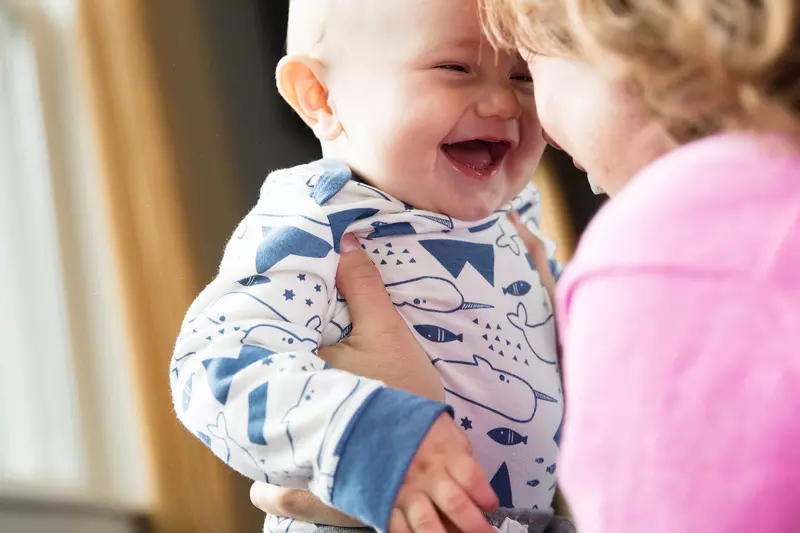- AdventHealth

Crawl Before You Walk
The adage, You must learn to crawl before you can walk, is one of the oldest and truest for a good reason. Scientists and doctors keep finding new evidence to support that crawling is crucial to the development of not only a child's ability to later walk, but to many other aspects of development, as well. In fact, crawling forms the basis for most other motor skills including the ability to hold a pencil or more importantly the ability to even find and focus on a pencil in the first place.
In this second in a series of three blogs exploring a baby's development through crawling we'll be exploring all of the physical changes that happen when they start scooting around. You can navigate to Volume 1: Tummy Time and to Volume 3: Developing the Other Senses here or at the bottom of this second volume.
The Benefits of Crawling Volume 2: Crawling
Once the baby has everything they need in place, they'll begin to crawl. Crawling helps strengthen the center of the body, the neck, hips, back, shoulders and the arms, which builds a stable base to support the development of hand and finger skills. It also strengthens the core muscles, and helps with developing stability in the bones of the shoulder joint. The ball and socket joints of the shoulders and hips are shallow and unstable at birth but are molded into stronger, more stable joints through weight-bearing. As the proximal joints and muscles strengthen, they begin to provide a stable base to support further development of gross motor and fine motor skills.
Crawling on hands and knees requires a blend of stability of the torso and core muscles and movement of each limb. This blending is one of the foundations of goal directed movement; movement that is not reflexive in nature. Movements involved in learning and continuing to crawl can actually help lengthen and strengthen the muscles surrounding the rib cage. While pivoting and crawling, your baby will lengthen and strengthen the muscles that allow for proper expansion (broadening) and movement in his/her rib cage. The rib cage is very important for graded respiratory control (smoothly breathing in and out), especially while eating, talking, and moving.
As with most motor skills, the more this cross-lateral movement pattern is practiced, the stronger the pathway and communication between the left and right sides of the brain becomes. This bilateral coordination, which is when the opposite sides of the body work together, activates a special part of the brain called the corpus callosum. The corpus callosum is a bundle of over 200 million nerve fibers located directly between the left and right hemispheres of the brain, and is responsible for helping the left and right sides of the brain communicate with each other, acting like a messenger bridge. Left to right brain communication is important for skills requiring coordination of the two sides of the body such as when clapping, walking/running, catching a ball, getting dressed or undressed, riding a bike, holding a paper while coloring or cutting, and even when reading and writing. What babies do or don't do during this phase of life can literally change and affect the structure of their brain.
As babies learn to coordinate the two sides of their body while crawling, they are also beginning to learn a sense of rhythm, space, and timing. Crawling is a rhythmic pattern of movement and non-movement which teaches babies to move two limbs while not moving the other two in order to achieve efficient, coordinated whole-body movement. As this rhythmic sequence is executed, babies then experience space as they move from here to there, and experience time as they compare moving to non-moving. This physical understanding of space and time enables rhythmic, controlled, efficient movements of the body and prepares babies for later skills such as walking, running, and using their bodies efficiently.
As babies become more proficient with crawling, they begin to experiment with carrying small items in one hand as they crawl. They tend to do this by holding the item with the thumb, index, and middle fingers while curling their ring and pinky fingers into their palm for stability. The thumb side, or radial side, works while the pinky side, or ulnar side, stabilizes. Weight shifting when crawling also elongates the web space between the thumb and index finger, creating more room for grasping objects. It also stimulates active stabilization of the thumb. The hand expands or flattens itself during weight bearing in quadruped positions, crawling, and bear-walking. Hand expansion is a prerequisite to grasp, as well as the manipulation and release of objects. Efficient pencil grasp among the crawlers has been shown to be significantly better than among non-crawlers.
Next, we move on to Volume 3: Developing the Other Senses where we'll learn about all the other benefits that crawling provides to babies. And heres the link in case you missed it or want to review Volume 1: Tummy Time.
If you have concerns that your child did not spend enough time crawling or did not achieve some of these important milestones, please make an appointment to see one of our specialists at AdventHealth Sports Med and Rehab.



